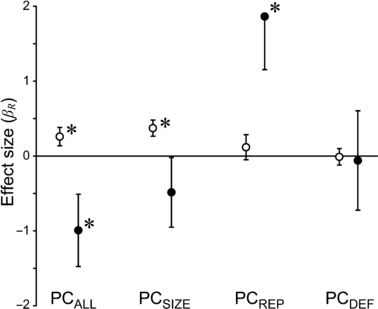Common garden comparisons of native and introduced plant populations: latitudinal clines can obscure evolutionary inferences
- PMID: 25567860
- PMCID: PMC3352372
- DOI: 10.1111/j.1752-4571.2008.00053.x
Common garden comparisons of native and introduced plant populations: latitudinal clines can obscure evolutionary inferences
Abstract
Common garden studies are increasingly used to identify differences in phenotypic traits between native and introduced genotypes, often ignoring sources of among-population variation within each range. We re-analyzed data from 32 common garden studies of 28 plant species that tested for rapid evolution associated with biological invasion. Our goals were: (i) to identify patterns of phenotypic trait variation among populations within native and introduced ranges, and (ii) to explore the consequences of this variation for how differences between the ranges are interpreted. We combined life history and physiologic traits into a single principal component (PCALL) and also compared subsets of traits related to size, reproduction, and defense (PCSIZE, PCREP, and PCDEF, respectively). On average, introduced populations exhibited increased growth and reproduction compared to native conspecifics when latitude was not included in statistical models. However, significant correlations between PC-scores and latitude were detected in both the native and introduced ranges, indicating population differentiation along latitudinal gradients. When latitude was explicitly incorporated into statistical models as a covariate, it reduced the magnitude and reversed the direction of the effect for PCALL and PCSIZE. These results indicate that unrecognized geographic clines in phenotypic traits can confound inferences about the causes of evolutionary change in invasive plants.
Keywords: EICA; biogeographical comparisons; clinal variation; common garden; evolution of invasive species; introduced plants; latitudinal gradients.
Figures



References
-
- Abramoff MD, Magelhaes PJ, Ram SJ. Image processing with ImageJ. Biophotonics International. 2004;11:36–42.
-
- Barrett SCH, Colautti RI, Eckert CG. Plant reproductive systems and evolution during biological invasion. Molecular Ecology. 2008;17:373–383. - PubMed
-
- Blossey B, Nötzold R. Evolution of increased competitive ability in invasive non-indigenous plants: a hypothesis. Journal of Ecology. 1995;83:887–889.
-
- Blows MW, Hoffman AA. A reassessment of genetic limits to evolutionary change. Ecology. 2005;86:1371–1384.
-
- Bossdorf O, Prati D, Auge H, Schmid B. Reduced competitive ability in invasive non-indigenous plants: a hypothesis. Journal of Ecology. 2004;83:887–889.
LinkOut - more resources
Full Text Sources
Other Literature Sources

